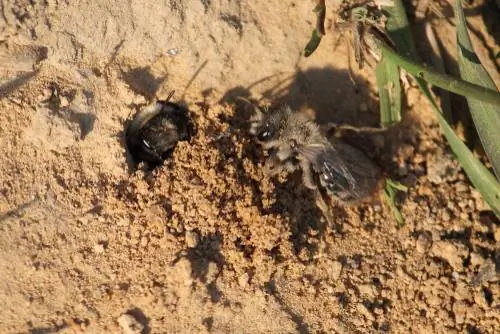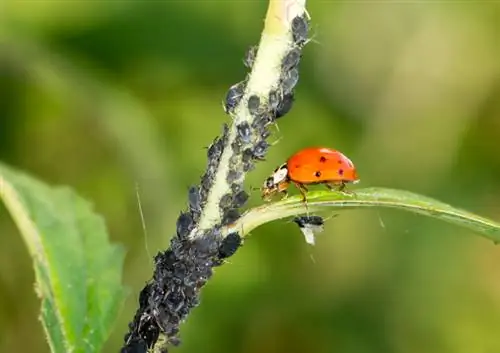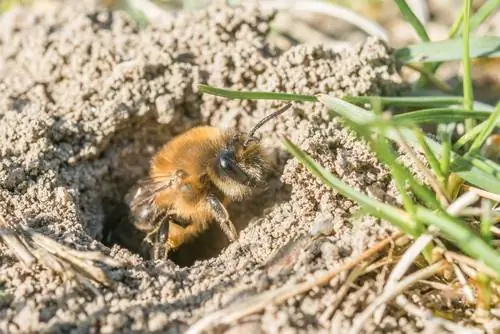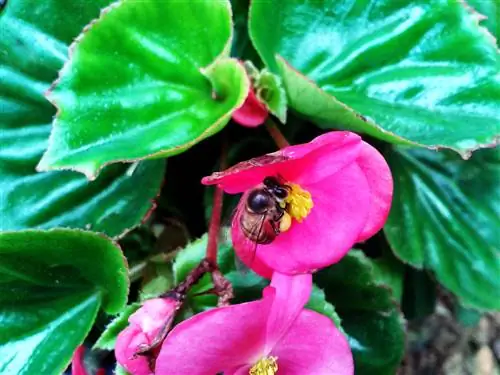- Author admin [email protected].
- Public 2023-12-16 16:46.
- Last modified 2025-06-01 06:02.
Earth bees are extremely diverse insects that have adapted to very specific habitats. Many of the species use certain plants as a food source. They are threatened by various factors and should be encouraged more in the garden because their benefits are of great importance.

What are earth bees?
Soil-dwelling bees are called earth bees. They represent the genus of sand bees (Andrena) and are represented worldwide with more than 1,500 species. Around 150 sand bees are native to Central Europe, of which 116 species have been observed in Germany.

What to do if there are sand bees in the garden?
Sand bees are often responsible for holes in the lawn. They can also dig tunnels in the substrate of flower pots or flower boxes so that they can be observed on balconies and terraces in spring. However, there is no reason to combat them as the insects pose no danger.
Deterrence measures are only considered in extreme exceptional cases, for example when the animals nest in large numbers near kindergartens. Relocating the nests requires an exceptional permit. The survival of the sand bees has the highest priority in all measures and methods. The use of insecticides or home remedies is neither recommended nor necessary.
Humidify caves
If you want to get rid of sand bees, you can carefully moisten the cave entrances. Make sure the animals don't drown. When the habitat becomes too wet, sand bees abandon the construction of their burrows and look for an alternative location. This method only works when the females are still busy excavating. If they have already sealed the entrances, larval development is in full swing. From then on you are no longer allowed to water the breeding grounds as you endanger the offspring.
Withdraw the sun
You can also drive away sand bees by permanently shading them. Set up a parasol or stretch an awning over the open area inhabited by a female. It quickly notices that the living conditions are no longer optimal and stops building the cave. This method is only recommended if the female has not yet closed the entrances. If there are already eggs in the nest, development is jeopardized by the lack of warmth.

Earth bees don't feel comfortable in the shade
Protecting sand bees
Instead of eliminating the beneficial insects, enjoy the species in your garden. You can be sure that your garden is one of the natural and special habitats. If you would like to do something to protect earth bees, you can redesign your garden and balcony accordingly and plant them in a natural way. The more varied the habitat, the greater the chance of successful colonization by sand bees.
Create small habitats
Set up flower boxes or pots filled with sand to provide the sand bees with a suitable substrate for building nests. The container should be placed in a sun-exposed area in the garden or on the balcony, as the animals need warmth.
If you have enough space in the garden, you can also surround a small area with hollow blocks or quarry stones and fill it with drift sand or loamy sand to a height of about 50 to 100 centimeters. As an alternative to stones, you can also use dead wood trunks and thus provide a habitat for several specialized insect species.
Tip
If you have wide eaves, you can make a sand bed right next to the house. Here the nesting boxes are optimally protected from rain.
Keep paths open
Small trails in the garden offer some species particularly good conditions. The floor is kept open by steps. The bryony sand bee prefers such slightly compacted areas. Consider whether all paths in the garden really need to be paved. If there is no alternative, you can lay the paving stones with the largest possible joints. Even then, sand bees still find good opportunities to build nests.
Planting food sources
If the habitat is right, all that's left is to equip the garden with suitable nectar plants. The more diverse you design the garden, the more species will be appealed to. In order to attract rarer species to the garden, special food plants must be present. The bryone sand bee nests in gardens where male specimens of various bryony species also grow.
Tip
It's worth taking a closer look at the sand bees' diet. Many species prefer plants that require a minimum of care to grow.
What do earth bees look like?
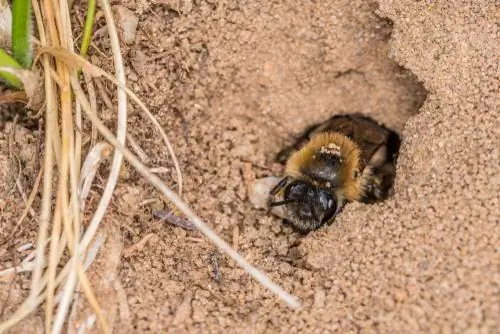
Sand bees are particularly furry and less conspicuously colored
These wild bees look very different. There are very small species that reach five millimeters long. The large sand bees reach a length of 16 millimeters. Their basic color varies from black to black-red and can rarely have a metallic shine.
Most earth bees have furry hair and can be identified by a light fringe of hair on their abdomen. There are hairbrushes on their hind legs that sand bees use to collect pollen from the stamens. Various characteristics can be used to distinguish males and females from one another.
| male | Female | |
|---|---|---|
| Hinds | without lock of hair | with lock of hair |
| Face | lightly spotted | velvety hairy pit |
| Sensor | 13 links | 12 links |
Difference between earth wasps and earth bees
Earth wasps display aggressive behavior and therefore appear intrusive. Sand bees, on the other hand, are shy and withdrawn. But both insects only sting when threatened. A characteristic distinguishing feature is the hairiness, because earth wasps are often only hairy in places and can therefore be clearly distinguished from the furry, hairy earth bees.
The insects can be distinguished not only by their appearance, but also by their lifestyle and nest building. While the earth wasp usually only uses one entrance to the underground cave, the earth bee digs several holes. They usually use the cave for many years. Earth wasps look for new quarters the following year.
Lifestyle and development
Unlike honey bees, sand bees do not form a colony. They live as loners. The female is solely responsible for building her nest and caring for her offspring. Rarely, several females form nest aggregations in the immediate vicinity. However, shared use is the exception. The native species are active in spring and fly predominantly between April and June. There are a few species that can be observed until late summer.
Nest building
In spring, mating and egg laying occur in tunnels five to 60 centimeters deep. The females dig their own breeding burrows by compacting the soil into clumps with saliva and carrying them out of the burrow. The clods of earth are piled up around the entrance.
During the construction process, clods of earth often roll back into the hallway and then have to be carried outside again. Downpours support the construction work. The clods of earth are moistened and harden after drying, creating a stable entrance.
Sand bees don't actually build honeycombs but rather branch nests that have a vertical main entrance. This branches into short side passages, each of which ends in a brood cell. The nest is arranged predominantly vertically. The female puts pollen and nectar in each brood cell so that the larvae that hatch later have enough food. An egg is placed in each brood cell before it is closed.

From larva to bee
When the larvae hatch, they feed on the food provided in the shelter of the cave. This is sufficient until pupation, because the mother does not care for the brood any further. Many bee larvae, such as those of the common sand bee, develop a protective cocoon that they spin from their own glandular secretions.
When the new generation hatches depends on the climatic conditions. If the winters are mild, the adult sand bees emerge from their burrows in late summer. In Germany, sand bees only emerge the following spring, with males freeing themselves from their cocoons before females. They try to mate with them directly.
Food
Sand bees are very specialized when it comes to food. Their diet includes pollen and nectar from asparagus, cinquefoil and speedwell, but also from many daisy family plants, umbelliferous plants, cruciferous plants and butterfly flower plants. Many species use different food sources. The red-furred sand bee prefers to fly to currant and gooseberry bushes, but also takes other food plants. About half of the native earth bees fly exclusively to certain nectar plants.
- Willow Sand Bee: Pollen and nectar from willows
- brow sand bee: specialized in bryone species
- Knautia Sand Bee: Field Scabious, Pigeon Scabious
Winter
Many of the bees native to Germany pupate in late summer, but spend the cold season in the protection of the cocoon. Only next spring will the insects hatch and crawl out of their burrow. The parents do not survive the winter.
Natural enemies
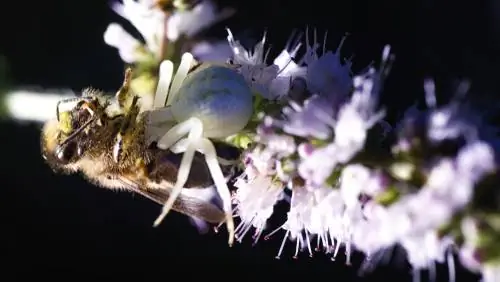
Crab spiders like to eat bees
There are many enemies that can be the downfall of sand bees. Predators benefit from the protein-rich insects, while parasites and fungi attack sand bees and their larvae in other ways.
Robbers
Predators prey on sand bees as full insects. These include crab spiders, which lie in wait on the flowers of their prey and wait for them to visit. Digger wasps can also pose a danger to ground bees. These paralyze the insects with a sting and then suck them out.
More predators:
- various robber fly species
- Types of predatory bugs
- insectivorous birds such as bee-eaters
Parasites
Sand bees are endangered by oil beetles, fan-winged beetles and woolly floaters. Many cuckoo bees, such as blood bees or wasp bees, lay their eggs in the underground nests of sand bees. In this way, cuckoo bees save themselves from having to search for food because their larvae feed on pollen and nectar in the brood cells. Such parasite species have specialized on a few host animals. They depend on its existence and continued existence.
Excursus
This is how sand bees protect themselves against parasites
Some sand bee species such as the Scottish earth bee and other species that are not native to Germany live communally. Usually several sister females live together in one nest. This is started by a female and expanded by the sisters. In this way, latecomers save themselves the hassle of digging tunnels in particularly hard soil. In addition, the females living in the tunnels can protect the brood from invading parasites. Solitary sand bees that leave their nest after laying their eggs do not enjoy this protection.
Fungi and bacteria
The spread of mold or bacteria in the enclosed breeding cells can have devastating effects. Therefore, sand bees are very picky about their choice of nesting sites. They avoid habitats with dense vegetation or excessive waterlogging, as these offer optimal living conditions for fungal spores and bacteria. Instead, the insects choose warm and dry environments.
These habitats are unattractive for fungi and bacteria:
- dusty sidewalks
- poor vegetation and sunlit embankments
- loosely vegetated and sunny lawns
Species and habitat

The bicolor sand bee can be recognized - as the name suggests - by its two colors (brown and yellow)
Sand bee species are predominantly found on the northern continents. Most ground bees prefer habitats that have dry and warm conditions. Unlike mason bees, which like to nest in window frames, sand bees look for loose substrates to create a breeding site. Open soils with sandy areas provide optimal conditions for building caves. Soils with high amounts of clay make it difficult to build nesting holes.
The species got their German name because they are mainly distributed in sandy habitats. They differ greatly in their appearance and show differences in flight times, food range and habitat.
| Scientific name | Flight time | Nisting site | Food | Status | |
|---|---|---|---|---|---|
| Blue Iridescent Sand Bee | Andrena agilissima | May - July | Step walls | Cruciferous vegetables | rare |
| Bicolor Sand Bee | Andrena bicolor | March - August | Forest edges, bushes, gardens, parks | Bluebells | often |
| Gray Black Sand Bee | Andrena cineraria | April - May | Gravel pits, river landscapes, forest edges, gardens | various plants | often |
| Common Sand Bee | Andrena flavipes | April - August | Forest edges, hedges, pits, gardens | Umbelliferous and daisy family, buttercup and rose family | often |
| Scottish Earth Bee | Andrena scotica | April - May | Dry grass, natural meadows, gravel areas | various plants | often |
Harmful or useful?
Sand bees do not pose a danger to humans, nor are they harmful to other living beings or plants. Even if many people are afraid of the massive appearance of bees in spring, there is no reason to worry. Sand bees do not display aggressive behavior. They are shy and do not defend their nests.
The males are unable to sting. Although the females have a stinger, they rarely use it in dangerous situations. However, the stinger is too weak to penetrate human skin. You can let children and pets play in the garden without worry and enjoy the ecological benefits of sand bees.
Why sand bees are useful:
- pollinate various plants
- increase the harvest of fruits and vegetables
- indicate valuable habitats as they occur in threatened habitats
- loosen the soil
Nature conservation in Germany
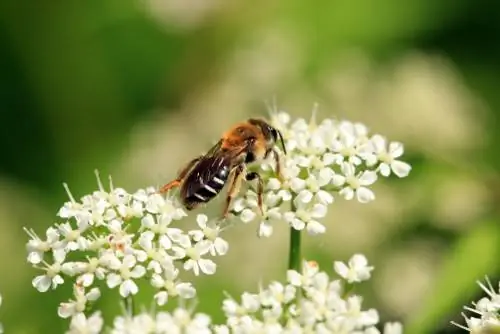
Earth bees also pollinate flowers and are therefore particularly important for us and our environment
Although most native sand bee species are common, earth bees are protected. The bee population is declining dramatically. If the pollinating insects die out, many plants will have no opportunity to reproduce. According to the Federal Nature Conservation Act, it is forbidden to capture, disturb or kill animals. Protection also applies to nests that may not be removed, destroyed or relocated without special permission. Some Andrena species are already considered endangered because their habitats are becoming scarce. Andrena marginata is even critically endangered.
Changing environmental conditions and human intervention are having devastating consequences for sand bees.
Sand bees in danger
Many sand bee species are still common in Germany, but the situation can change quickly. Natural nesting sites are found on poor, dry grassland with sandy ground. Forest fires, floods or landslides continually create open sites that are colonized by sand bees. More and more of these habitats are being destroyed, so the insects have to reorient themselves. They colonize locations close to humans. But human intervention is ensuring that such habitats are also becoming rare. Gravel and sandy paths are covered with tar and areas are improved.
This endangers sand bees:
- Shortage of food supply
- Ignorance of people
- monotonous garden design
Frequently asked questions
Do earth bees make honey?
Sand bees collect pollen and nectar, but they do not produce honey from them. The insects use plant nectar donors as a source of food for themselves and to create a food basis for their offspring. To do this, they equip each brood cell with pollen before laying their eggs in order to lay their eggs on it. The larvae have to feed on this until they pupate, because they don't leave the cave until the following year.
When do earth bees hatch?
The larvae hatch in the breeding cavity shortly after laying their eggs if there is enough warmth. They stay in the shelter of the underground tunnels until they pupate and usually overwinter in their cocoon. It is only in the following spring that the young insects bite through their protective shell and free themselves from the closed burrows. Most sand bee species fly between April and June.
Are earth bees dangerous?
The very differently colored species pose no danger. Sand bees do not defend their nests. The female leaves after laying her eggs. If it finds itself in a dangerous situation, it tries to defend itself. However, these defense methods are completely harmless to humans.
Do earth bees have stingers?
Male are stingless. Only the females have a stinger with which they can sting in case of danger. The sting is not dangerous to humans because the delicate stingers cannot pierce the skin. You don't have to worry about being bitten by your dog when it's running around.
How old do sand bees get?
After males have mated, they die. The complex part of life now begins for the females, as they build the nesting cavity and provide the individual brood cells with food. About four weeks after mating activities, the females also die. The larvae overwinter in their cocoon in order to crawl out of the breeding cavity in the coming spring. Then the drama begins again.
What do you do about earth bees?
For species protection reasons, combating them is out of the question. Removing and destroying the nests is just as punishable as catching and killing the insects. Relocation requires an exceptional permit.

